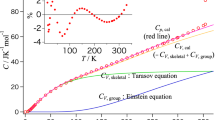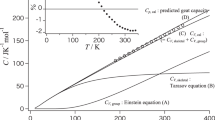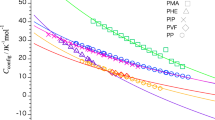Abstract
RECENTLY, Starkweather1 has shown that the model for the heat capacity of chain crystalline polymers proposed by Stockmayer and Hecht2 can be very, useful in understanding thermal motions of polymers at low temperatures. The model assumes that groups in the chain vibrate as units and that there are strong-primary bonds between the units and weak interactions between adjacent chains. The temperature dependence of the heat capacity, Cv, can be expressed in terms of two ratios, Cv/3Nk and T/Tm, where N is the number of vibrating groups per gm., Tm equals hνm/k, where h and k are Planck and Boltzmann constants, and νm is the maximum frequency of vibration. Starkweather1, using published Cp data and the Stockmayer–Hecht model, was able to calculate the parameters, Tm, νm, 3NK, and the weight of the repeating unit for crystalline polytetrafluoro-ethylene and for conventional 55 per cent crystalline polyethylene. It is the purpose of this communication to extend this previous work1,2 to amorphous chain polymers and to present the calculated values for the above parameters for polystyrene (PS) and poly-methylmethacrylate (PMMA).
This is a preview of subscription content, access via your institution
Access options
Subscribe to this journal
Receive 51 print issues and online access
$199.00 per year
only $3.90 per issue
Buy this article
- Purchase on Springer Link
- Instant access to full article PDF
Prices may be subject to local taxes which are calculated during checkout
Similar content being viewed by others
References
Starkweather, H. W., J. Polymer Sci., 45, 525 (1960).
Stockmayer, W. H., and Hecht, C. E., J. Chem. Phys., 21, 1954 (1953).
Sochava, I. V., and Trapeznikova, O. D., Vestnik, Leningrad Univ., 13, No. 16, Ser. Fiz. i. KHim, No. 3, 65 (1958).
Warfield, R. W., and Petree, M. C., J. Polymer Sci., 55 (1961).
Warfield, R. W., and Petree, M. C. (to be published).
Tarassov, V. V., Doklady Akad. Nauk, S.S.S.R., 100, 307 (1955).
Dole, M., Adv. Polymer Sci., 2, 221 (1960).
Krimm, S., Adv. Polymer Sci., 2, 51 (1960).
Sinnott, K. M., J. Polymer Sci., 42, 3 (1960).
Warfield, R. W., and Petree, M. C., Naval Ordnance Lab. Tech. Rep. 61 (1961).
Author information
Authors and Affiliations
Rights and permissions
About this article
Cite this article
WARFIELD, R., PETREE, M. Heat Capacity of Amorphous Polymers at Low Temperatures. Nature 193, 1280–1281 (1962). https://doi.org/10.1038/1931280b0
Issue Date:
DOI: https://doi.org/10.1038/1931280b0
This article is cited by
-
Heat capacity and thermodynamic functions of polyvinyl alcohol
Kolloid-Zeitschrift & Zeitschrift für Polymere (1962)
Comments
By submitting a comment you agree to abide by our Terms and Community Guidelines. If you find something abusive or that does not comply with our terms or guidelines please flag it as inappropriate.



